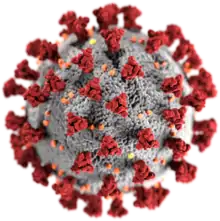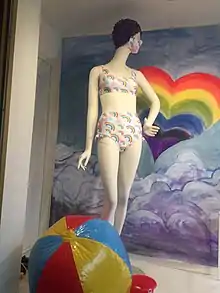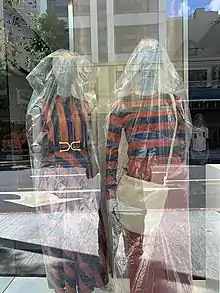Impact of the COVID-19 pandemic on the fashion industry
The COVID-19 pandemic affects the global fashion industry as governments close down manufacturing plants, and through store closures, and event cancellations[1] to slow the spread of the virus. The coronavirus pandemic has had a major impact on fashion brands worldwide.[2] At the same time, the fashion industry faces challenges in consumer demand.[3] New opportunities are also presenting themselves as fashion brands shift to making fashionable coronavirus face masks.[4][5]
| Part of a series on the |
| COVID-19 pandemic |
|---|
 |
|
|
|
Manufacturing
Manufacturing issues include lack of fabric availability and order cancellations, but brands that prepared originally by importing fabrics and have them stored at a safehouse will benefit from the pandemic.[6]
Distribution channels
As retail stores shut their doors and stay-at-home orders kept people inside, there was a dramatic shift towards digital commerce that is likely to continue post-pandemic. Consumers had to increase their use of services like social commerce and curbside pickup and retailers had to offer digital solutions in order to survive.[7] Sales from physical brick-and-mortar stores and department stores are down and expected to continue decreasing while direct-to-consumer online retailers are on the rise.[8]
Sales
Apparel is a leading discretionary purchase. Inasmuch as many people are staying at home, there is less emphasis on dressing for formal contexts. Likewise, many people make clothing purchases ahead of special occasions, such as weddings and vacation, but as many of these events have been canceled or postponed that need longer exists. Layoffs, furloughs and pay cuts are also affecting sales.[9]
Events
Designers have adapted with producing and showcasing their fashion products by streaming presentations online without a live audience present.[10] The British Fashion Council made an announcement in April 2020 that it would develop a digital “cultural fashion week platform” that designers could use in any way that they thought would work for them rather than facilitating the typical format and setting of a fashion show. Shanghai and Moscow fashion weeks were presented digitally in late March and April 2020. Ermenegildo Zegna coined the word "phygital" to describe "physical space and digital technologies" as its new way of showcasing fashion.[11]
As art galleries and museums were closed, First American Art Magazine organized a virtual art exhibition and asked the Native art community to submit masks. More than seventy artists handed in 125 masks, from functional masks to decorated ones.[12]
High Fashion

The on-going COVID-19 pandemic will inevitably change the fashion industry forever. The necessity to purchase clothing on a frequent basis no longer exists, and numerous brands and historic department stores have closed for good.[13]
That said, face masks have been trending as a fashion statement during the COVID-19 pandemic.[14] It has been suggested that possibly "no other piece of clothing has had a trajectory like face masks — something that began as purely protective transforming into a fashion statement in no time at all."[15] The Trikini in Italy, for example, consists of two piece beachwear and a matching mask.[16][17][18][19] More broadly they have appeared on the catwalk as a part of the haute couture's industry turn towards a utilitarian flair, and furthermore with the global rollout of effective vaccines thought is now being given to "the post-COVID look."[20]
References
- Ilchi, Layla (17 March 2020). "How the Coronavirus Is Impacting the Fashion, Beauty and Retail Industries". Women's Wear Daily. Retrieved 7 May 2020.
- Silver, Katie (7 May 2020). "Small fashion brands in Asia hit by coronavirus". BBC News. Retrieved 7 May 2020.
- Law, Tara (3 March 2020). "How Coronavirus' Effect on the Fashion Industry Reveals Flaws in the Global Economy". Time. Retrieved 7 May 2020.
- Philipkoski, Kristen (12 April 2020). "30+ Fashion Brands Pivoting To Make Stylish Coronavirus Masks". Forbes. Retrieved 8 May 2020.
- Friedman, Vanessa (22 April 2020). "Should Masks Be a Fashion Statement?". The New York Times. Retrieved 8 May 2020.
- Roberts-Islam, Brooke (13 April 2020). "Designer And Supply Chain Digital Revolution: How COVID-19 Is Changing The Fashion Industry". Forbes. Retrieved 7 May 2020.
- "COVID-19: Impact on retail consumer behavior | Accenture". www.accenture.com. Retrieved 11 October 2020.
- Coffman, Courtney (19 June 2018). "Shops Aren't for Shopping Anymore". The Atlantic. Retrieved 11 October 2020.
- "How coronavirus could alter the way we shop for clothes from now on". TODAY.com. 30 April 2020. Retrieved 8 May 2020.
- "2020 Fashion week innovations". fashionunited.com. 1 May 2020. Retrieved 7 May 2020.
- Friedman, Vanessa (2 May 2020). "Is This the Future of the Fashion Show?". The New York Times. Retrieved 7 May 2020.
- "Masked Heroes: Facial Coverings by Native Artists". First American Art Magazine. 15 June 2020.
- Gonot, Stephanie. "Sweatpants Forever". The New York Times Magazine. New York Times.
- "Face Masks as a Fashion Accessory? Why We Should Encourage This Trend". Healthline. Retrieved 11 May 2020.
- Givhan, Robin (4 May 2020). "Masks are here to stay. And they're quickly becoming a way to express ourselves". Washington Post.
- CONCOLINO, NIVES (26 April 2020). "Trikini, il costume da bagno con la mascherina". il Resto del Carlino (in Italian). Retrieved 28 April 2020.
- "Coronavirus, sarà l'estate del trikini: il costume abbinato alla mascherina. FOTO | Sky TG24". tg24.sky.it.
- Deabler, Alexandra (12 May 2020). "Italian designer launches 'trikini' beachwear design, complete with matching bikini and mask set". Fox News. Retrieved 13 May 2020.
- "Coronavirus: New 'trikini' trend boasts bikini & matching face masks". Capital. Retrieved 13 May 2020.
- https://www.bbc.com/news/entertainment-arts-55235566 Fashion Lookahead: Eight major 2021 looks ... bbc.com, 30 December 2020
